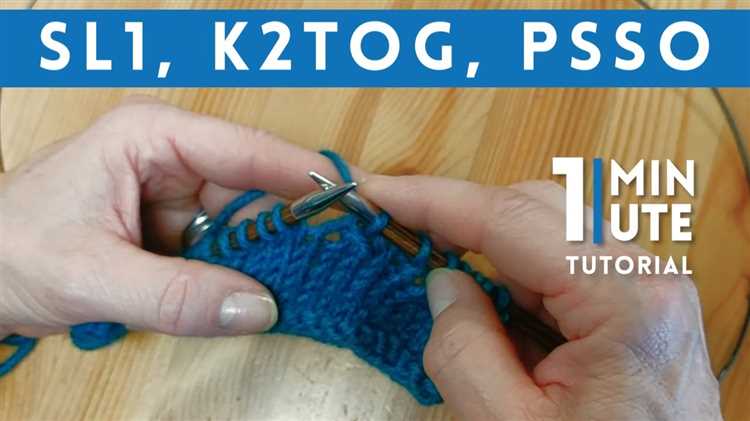Knitting is a beloved craft that allows you to create beautiful and functional items with just a few simple tools. However, to truly master knitting, it’s important to learn a variety of knitting techniques. One technique that every knitter should know is the PSSO, which stands for “pass slipped stitch over.” Understanding how to PSSO will open up a world of new stitch patterns and designs, allowing you to take your knitting to the next level.
The PSSO is commonly used in lace knitting and decorative stitch patterns. It involves slipping a stitch from your left needle to your right needle without knitting or purling it, and then passing it over the next stitch on your right needle. This creates a decrease in your knitting, making it a useful technique for shaping your work or adding texture to your design.
To execute the PSSO, follow these steps: 1) Insert your right needle into the first stitch on your left needle as if you were going to knit it, but instead, just slip it onto your right needle. 2) Knit the next stitch on your left needle. 3) Using the tip of your left needle, lift the slipped stitch on your right needle up and over the knit stitch, letting it pass over and off the needle. 4) Continue knitting or purling the next stitches as instructed by your pattern.
The PSSO can be a bit tricky to master at first, but with practice, it will become second nature. It’s important to keep an even tension as you execute the PSSO, as a too-tight tension can create a distorted or puckered effect on your knitting. Additionally, pay attention to whether your pattern calls for a PSSO on the right or wrong side of your work, as this can affect the appearance of your stitches.
Learning how to PSSO in knitting opens up a world of possibilities for your projects. Whether you’re looking to add decorative elements to a shawl or create an intricate lace pattern in a pair of socks, mastering this technique will allow you to achieve stunning results. So take the time to practice the PSSO and experiment with incorporating it into your knitting. Before you know it, you’ll be creating intricate designs and stunning garments that will impress everyone who sees your work.
What is PSSO in Knitting?
PSSO stands for “pass slipped stitch over” and refers to a knitting technique used to decrease stitches. It is commonly used in lace and other decorative stitch patterns to create an eyelet or decrease the number of stitches on your needles.
When you encounter a PSSO instruction in a knitting pattern, it means that you need to slip the next stitch onto the right-hand needle as if you were going to knit it. Then, you pass the slipped stitch over the stitch that you just worked and off the needle.
The PSSO technique is usually paired with another stitch, such as a knit or a yarn over, to create an interesting stitch pattern. It is often used to create a central double decrease in lace knitting, where two stitches are decreased into one.
To perform a PSSO, follow these steps:
- Knit or complete the specified stitch before the PSSO instruction.
- Slip the next stitch onto the right-hand needle without knitting it.
- Insert the left-hand needle into the slipped stitch from left to right and pass it over the stitch you just worked.
- Slide the slipped stitch off the right-hand needle, leaving only one stitch on the needle.
It is important to note that PSSO is just one of many techniques used in knitting to decrease stitches. Depending on the stitch pattern or project you are working on, there may be other decrease methods, such as knit two together (K2tog) or slip slip knit (SSK), that achieve similar results.
By learning how to PSSO and other decrease techniques, you can add variety and complexity to your knitting projects and create stunning stitch patterns.
Benefits of Learning PSSO Technique
The PSSO technique, which stands for “Pass Slipped Stitch Over,” is a fundamental knitting technique that offers several benefits to knitters. Whether you are a beginner or an experienced knitter, mastering the PSSO technique can enhance your knitting skills and open up new design possibilities.
- Efficient Decreases: The PSSO technique is commonly used to decrease stitches and create shaping in garments, such as sleeves, necklines, and waistlines. By passing a slipped stitch over another stitch, you can decrease the total number of stitches in a row, creating a tailored fit in your knitted pieces.
- Enhanced Texture: The PSSO technique can add interesting texture and visual appeal to your knitting. When combined with other stitch patterns, such as lace or cables, the PSSO technique can create unique and intricate designs.
- Neat Finishing: The PSSO technique helps create a clean and polished finish to your knitting. By passing the slipped stitch over the following stitch, you can create a smooth transition, preventing any gaps or loose stitches in your work.
- Versatility: Once you have mastered the PSSO technique, you can apply it to a wide range of knitting projects. From simple scarves and hats to complex sweaters and blankets, the PSSO technique can be incorporated into various patterns and designs.
- Improved Knitting Skills: Learning the PSSO technique can enhance your overall knitting skills. It introduces you to new techniques and methods, such as slipping stitches, passing stitches over, and managing your tension. These skills can be transferred to other knitting techniques and help you become a more versatile and confident knitter.
Overall, mastering the PSSO technique is a valuable skill for any knitter. It offers efficient decreases, enhances texture, provides a neat finishing touch, offers versatility in design, and helps improve your overall knitting skills. By incorporating the PSSO technique into your knitting repertoire, you can take your projects to a new level of creativity and craftsmanship.
Step-by-Step Guide
Learning how to PSSO (pass slipped stitch over) in knitting is an essential technique to add to your repertoire. It is used to decrease stitches and create different stitch patterns, such as lace or cables. Follow this step-by-step guide to master the PSSO technique.
- Start with the working yarn at the back of your work.
- Slip the next stitch purlwise from the left needle to the right needle.
- Knit the next stitch on the left needle.
- Using the left needle, lift the slipped stitch over the knit stitch and off the right needle.
- You have successfully completed the PSSO stitch!
Remember to always follow the specific pattern instructions for when and how to PSSO. Here are a few tips to keep in mind while practicing the PSSO technique:
- Pay attention to the tension of your stitches to ensure an even and professional finish.
- Practice the PSSO technique on a small swatch or scrap yarn before starting a larger project.
- Take your time and be patient while learning the PSSO technique. It may take a few tries to get the hang of it.
- Experiment with different yarns and needle sizes to see the varied effects of the PSSO stitch.
Now that you have learned how to PSSO, you can incorporate this technique into your knitting projects. Whether you are creating intricate lace patterns or adding texture to your designs, the PSSO stitch will be a valuable skill in your knitting toolbox.
Common Mistakes to Avoid
Learning how to PSSO in knitting can be challenging at first, but with practice and patience, you can master this technique. To help you avoid common mistakes, here are some tips to keep in mind:
- Tension: Maintaining consistent tension throughout your knitting is crucial. Avoid pulling your yarn too tightly or leaving it too loose when passing the slipped stitch over.
- Slipping the Wrong Stitch: Double-check that you are slipping the correct stitch. It is easy to accidentally slip the wrong stitch, which can result in an incorrect stitch count and a misshapen project.
- Doing It Too Tight: When passing the slipped stitch over, be careful not to pull it too tightly. This can cause your knitting to become too tight and can make it difficult to insert your needle into subsequent stitches.
- Skipping the SSK: Before attempting the PSSO, make sure you have correctly performed the SSK (Slip Slip Knit) stitch. Skipping the SSK can lead to confusion and errors when trying to pass the slipped stitch over.
By being aware of these common mistakes and taking your time to practice, you will soon become comfortable with the PSSO technique and incorporate it smoothly into your knitting projects.
Troubleshooting PSSO Issues
While PSSO (pass slipped stitch over) is a relatively simple knitting technique, it can sometimes cause issues for knitters. Here are some common problems that arise when executing the PSSO stitch and solutions to troubleshoot them:
- Losing Stitches: In some cases, knitters may accidentally drop stitches while attempting to pass the slipped stitch over. It’s important to keep a firm grip on the working yarn and be cautious when performing the PSSO maneuver.
- Tight PSSO: If your PSSO stitch is too tight, it can create an uneven tension in your knitting. To remedy this, you can try using a larger needle to pass the slipped stitch over or loosen your tension while performing the stitch.
- Unraveled PSSO: If the slipped stitch is not properly secured after being passed over, it can unravel and create a hole in your knitted fabric. To prevent this, ensure that the stitch is securely wrapped around the needle before passing it over and tighten the working yarn if needed.
- Miscounting Stitches: It’s easy to miscount stitches when performing the PSSO stitch, as it involves skipping a stitch. To avoid this mistake, double-check your stitch count before and after executing the PSSO maneuver. Marking the slipped stitch with a stitch marker can also help keep track.
Remember, practice and patience are key when troubleshooting PSSO issues. By taking your time and paying attention to the details, you’ll quickly master this knitting technique.
Advanced Tips and Tricks
In this section, we will share some advanced tips and tricks to further enhance your PSSO technique in knitting.
1. Utilize Stitch Markers:
Using stitch markers can be a helpful tool when practicing the PSSO technique. Place a stitch marker before the stitch that needs to be passed over, which will serve as a reminder to perform the PSSO on that particular stitch.
2. Practice Tension Control:
Keeping an even tension is crucial for a clean and professional-looking PSSO. Practice controlling your tension by knitting the stitches before and after the PSSO stitch with the same level of tension.
3. Experiment with Yarn Overs:
Adding a yarn over (YO) before the PSSO can create an eyelet or decorative hole in your knitting. Play around with different variations of yarn overs to add interest to your projects.
4. Combine PSSO with Other Decrease Techniques:
Get creative and combine the PSSO technique with other decrease techniques. This can create unique textures and patterns in your knitting. Some common combinations include PSSO with knit two together (K2tog) or slip slip knit (SSK).
5. Try Different Needle Sizes:
Experimenting with different needle sizes can affect the appearance of your PSSO technique. Using larger needles can create a more open and loose stitch, while smaller needles can result in a tighter and denser stitch. Play around with different needle sizes to achieve the desired effect.
6. Use PSSO in Lace Knitting:
PSSO is commonly used in lace knitting patterns to create intricate designs and openwork. Explore lace knitting patterns to practice and showcase your PSSO skills.
7. Practice, Practice, Practice:
Like any knitting technique, mastering PSSO requires practice. Dedicate time to practicing this technique and incorporating it into your projects. As you become more comfortable, you’ll find new ways to incorporate PSSO into your patterns and create unique designs.
Using PSSO in Lace Knitting Patterns
Lace knitting patterns often include the use of PSSO (Pass slipped stitch over) to create beautiful designs and texture. PSSO is commonly used in lace patterns to decrease stitches and create eyelets or other decorative elements.
To perform PSSO, follow these steps:
- Knit or purl the specified number of stitches as indicated in the pattern before reaching the stitch where the PSSO is performed.
- Slip the next stitch from the left-hand needle to the right-hand needle without knitting it.
- Knit the following stitch on the left-hand needle.
- Insert the left-hand needle into the slipped stitch on the right-hand needle.
- Lift the slipped stitch over the knitted stitch and off the right-hand needle, passing it completely over the knitted stitch.
The PSSO is typically used in combination with other stitches or techniques to create unique lace patterns. It is often used to decrease stitches, creating a more open and airy fabric. The process of passing the slipped stitch over the knitted stitch creates a decorative element and visually separates the stitches.
When working with lace patterns that include PSSO, it is important to carefully follow the pattern instructions and count stitches to ensure the correct placement of the PSSO. Mistakes or skipped stitches can result in an uneven or incorrect pattern.
Overall, mastering the PSSO technique in lace knitting patterns can add depth and intricacy to your projects. Whether you’re creating delicate shawls, intricate doilies or other lace garments, incorporating PSSO can elevate your knitting skills and produce stunning results.
Creating Unique Designs with PSSO
The PSSO (Pass Slipped Stitch Over) technique in knitting is a versatile method that can be used to create unique designs and add visual interest to your projects. By incorporating PSSO into your knitting, you can create textured patterns, lace designs, and intricate motifs.
How PSSO Works
PSSO is often used in combination with other knitting techniques, such as decreases or yarn overs, to achieve different effects. The basic concept of PSSO involves passing a slipped stitch over another stitch, effectively decreasing the stitch count by one.
Here’s a step-by-step guide on how to perform PSSO:
- Knit or purl the first stitch, as indicated in the pattern.
- Slip the next stitch onto the right needle without knitting or purling it.
- Knit or purl the following stitch.
- Using the left needle, lift the slipped stitch up and over the stitch just knitted or purled.
- Drop the slipped stitch off the needle, leaving only the knitted or purled stitch.
- Continue following the pattern instructions.
Design Ideas with PSSO
PSSO can be used in a variety of ways to create stunning designs. Here are a few ideas:
- Lace Patterns: Incorporate PSSO into lace patterns by using it to decrease paired yarn overs. This creates an elongated stitch and adds a lacy, open effect to your knitting.
- Cable Twists: Use PSSO in cable patterns to create unique twists and turns. By passing a slipped stitch over a group of knitted stitches, you can create intricate cable designs with a three-dimensional appearance.
- Textured Patterns: Combine PSSO with different stitch patterns, such as knit or purl, to create textured designs. The slipped stitch adds visual interest and depth to your knitting, resulting in a beautifully textured fabric.
- Colorwork: Incorporate PSSO into colorwork projects to create stunning motifs and designs. By slipping stitches and passing them over, you can create patterns and shapes with contrasting colors.
Final Thoughts
PSSO is a valuable technique that can take your knitting to the next level. By mastering PSSO and experimenting with different design ideas, you can create unique and eye-catching projects that showcase your skills and creativity. So go ahead, give PSSO a try and see how it can elevate your knitting!
FAQ:
What does PSSO mean in knitting?
PSSO stands for “pass slipped stitch over” in knitting. It is a technique used to decrease stitches and create a decorative effect in your knitting.
When should I use the PSSO technique in knitting?
The PSSO technique is commonly used in knitting to create decorative edge stitches or to decrease stitches and shape the knitting. You can use it in various knitting patterns, such as lace patterns or decreasing stitches in a garment.
Are there any variations of the PSSO technique in knitting?
Yes, there are variations of the PSSO technique in knitting. One common variation is the SSP (slip, slip, purl) decrease, which creates a left-leaning decrease. Another variation is the SSK (slip, slip, knit), which also creates a left-leaning decrease but is worked slightly differently. These variations can give your knitting different effects and can be used based on the pattern you are working on.


